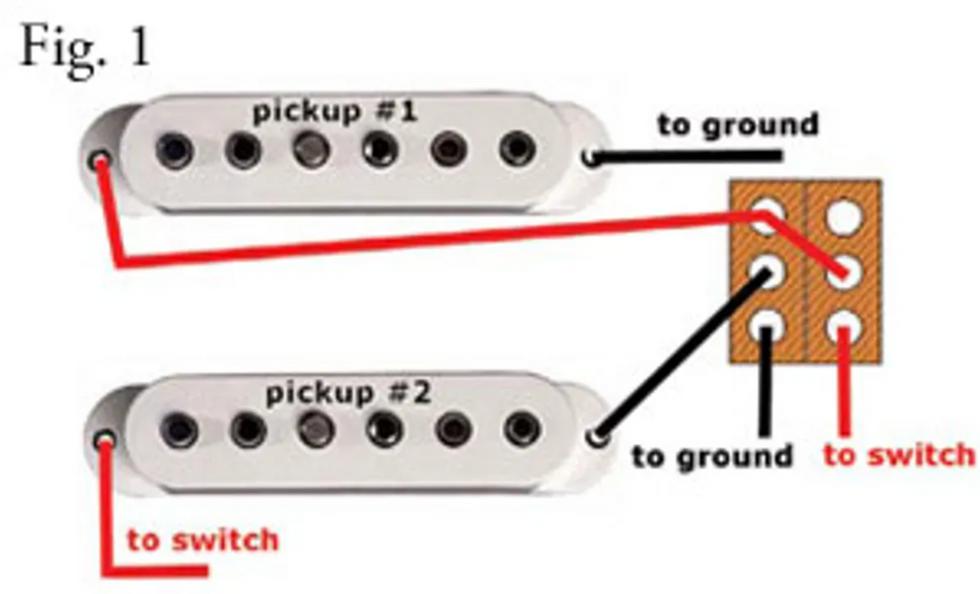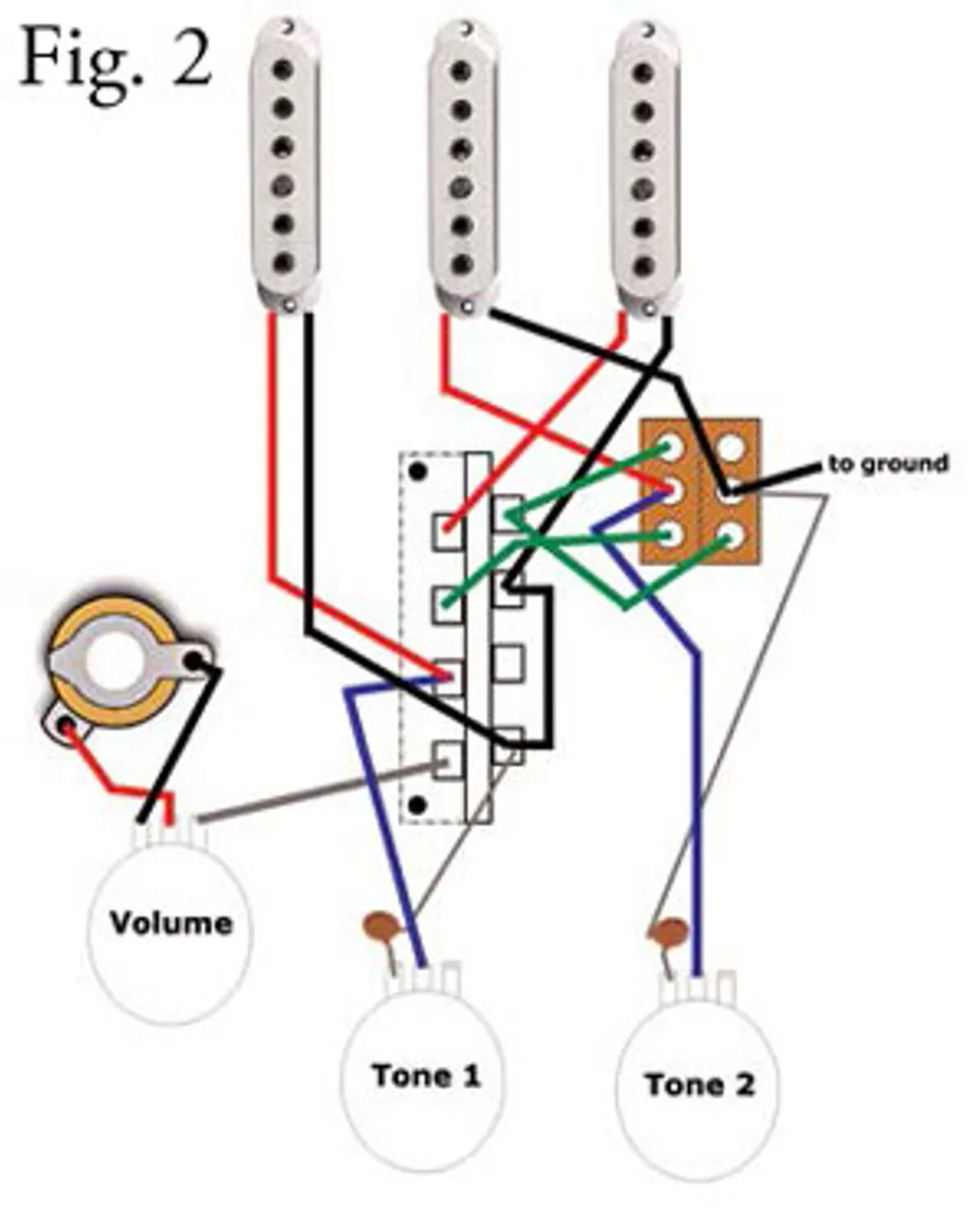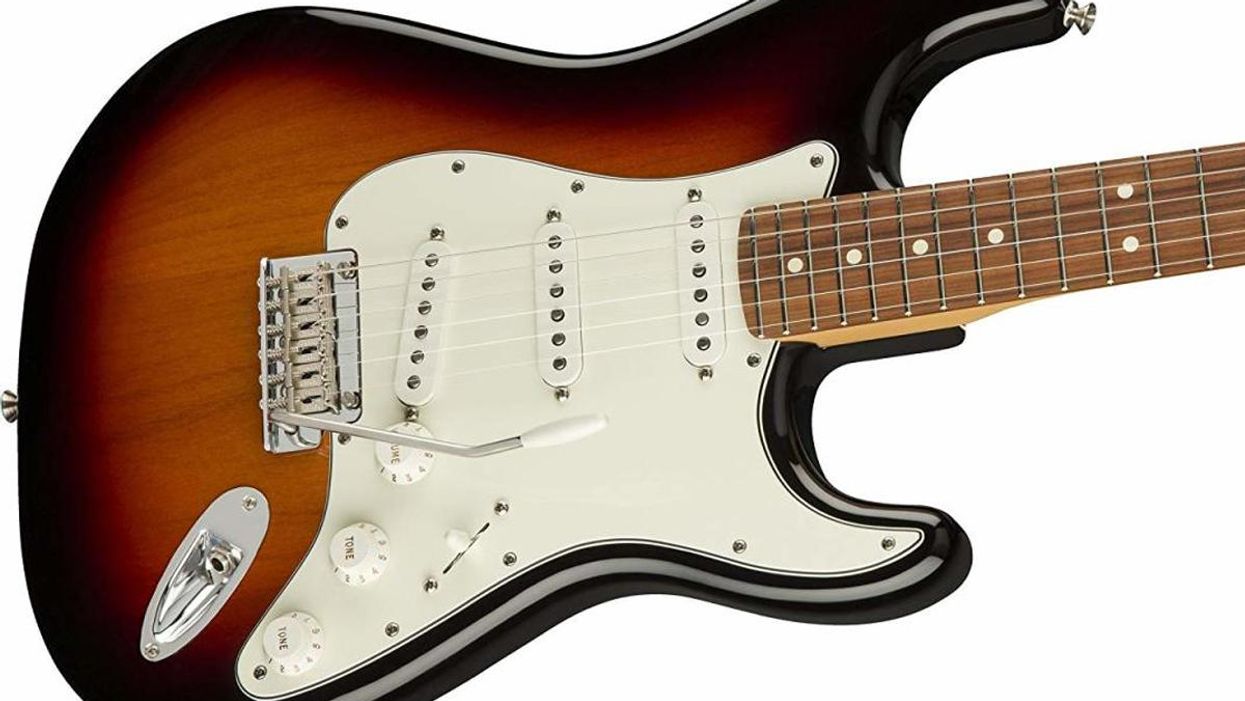This month, we again dive into parallel/series pickup switching for your Stratocaster. As you may recall from last month's column [“Stratocaster Parallel/Series Switching," December 2011], an individual single-coil Strat pickup cannot be wired in parallel or series by itself—you need a minimum of two pickups for this. To benefit from the series option, you need to use your Strat's dual-pickup settings—bridge + middle or neck + middle.

Fig. 1
Fig. 1 shows how to wire two pickups in parallel with the option of running them in series. Here, both pickups are wired to a normal DPDT (aka 2PDT) switch. In the down position, both pickups are connected in parallel—the standard Stratocaster configuration. This setting yields maximum chime and twang. With the toggle in the up position, pickup No. 2's ground is lifted and no longer connected to ground. Instead, it's now connected to the hot output of pickup No. 1, with the red jumper wire on the toggle switch making the connection.
Note: With normal Strat pickups, this works right from the start, but be careful when using humbuckers with only two wires (shield + hot), or one conductor pickups, in which the pickup ground and the shield wire are not separated. If you're working with humbuckers, be sure to use a unit with a 4-conductor wire that has the pickup ground separate from the shield wire, or let someone who knows what he's doing convert your standard humbucker. Desoldering the metal case and working with the super-thin internal pickup wires requires the right tools and some experience to avoid ruining the pickup. Ungrounding the shield will work, but you'll hear a buzz when you touch the pickup's metal casing, because the metal case will be included in the pickup circuit. The same holds true for single-coils with a metal casing that is connected to the pickup ground—and this includes all standard Telecaster neck pickups! We'll discuss this topic in detail in future columns.
So how can we add series switching to a Strat? There are many ways to do this, and if you do a Google search you'll find several approaches to series switching. Unfortunately, some of them are simply wrong. Most use two additional switches or complicated rotary switching, or wild combinations of these elements—sometimes even in conjunction with a 5-way super-switch.
Yes, we have to move more wires for this mod than we've done before, but after more than three years of Strat mods, you're no longer a novice, right? Series wiring is one of the supreme challenges in Strat modding, but you can do it!
My favorite Strat series-switching scheme only uses one normal DPDT switch and only affects the dual-pickup positions.

Fig. 2 shows the schematic in all its glory.
As always, you can use an additional mini toggle DPDT switch for this mod. Or, if you Adding Series Switching to Your Strat BY DIRK Wacker don't want to alter the stock appearance of your Strat, you can use a push/pull or push/ push pot of your choice. Most push/pull and push/push pots include a DPDT switch, so this shouldn't be a problem.
Operating this circuit is very easy: With the switch in the down position, both pickups are wired in parallel—the standard setting—when you select position 2 or 4 (bridge + middle or neck + middle).
But flip the switch up in position 2 or 4, and the respective two pickups are then wired in series to beat the devil out of your tube amp. In the other single-pickup positions (1, 3, and 5), the DPDT switch has no effect. That's easy enough, isn't it?
Another benefit of this particular approach to series switching is that it moves only the minimum wires required to do the job. Simple and clean. (The only downside of this mod occurs if you also use the “seven-sound mod" on your Strat. In that case, it will not connect the bridge and neck pickup together in series as well. If you need both mods, there's no way around having to install a second additional switch or a rotary switch with enough poles to accommodate all the positions.)
The schematic also incorporates individual tone caps for the middle and neck pickups, something I highly recommend for series wiring. You should lower the standard values a little bit, to prevent your tone from getting muddy in the series settings. Try 0.015 μF for the middle and 0.01 μF for the neck pickup.
As you can see, I chose to connect the middle pickup to the DPDT toggle switch. Because the middle pickup is involved in both dual-pickup positions, you only need one switch to give you two new tones. (This also explains why this wiring won't work for the seven-sound mod's combination of bridge + neck pickup. The middle pickup isn't active in this setting.)
On this note, we'll close out our Stratocaster mod series and shift over to Telecaster and Esquire mods next month. We'll start with a brief inspection of your guitars and look at some cool mods to enhance their primary tone. Until then, keep on modding!
[Updated 1/12/21]






































